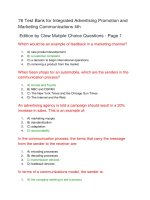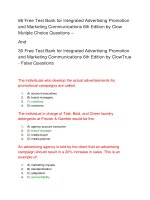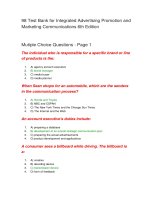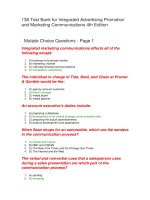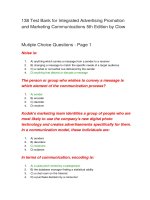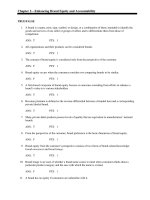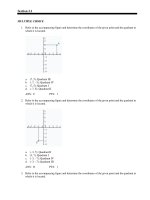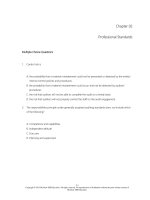Integrated advertising promotion and marketing communications 6th edition clow test bank
Bạn đang xem bản rút gọn của tài liệu. Xem và tải ngay bản đầy đủ của tài liệu tại đây (239.31 KB, 43 trang )
Integrated Advertising, Promotion, and Marketing Communications, 6e (Clow/Baack)
Chapter 2 Corporate Image and Brand Management
1) Applebee's rebuilt its brand by acquiring IHOP.
Answer: FALSE
Diff: 2
Question Tag: Definition (Concept)
Objective: 2-1
2) A firm's image is based on the feeling consumers and businesses have about the overall
organization and its individual brands.
Answer: TRUE
Diff: 1
Question Tag: Definition (Concept)
Objective: 2-1
3) Effective marketing communications are based on a clearly defined corporate image.
Answer: TRUE
Diff: 2
Question Tag: Critical Thinking
Objective: 2-1
4) What a firm's employees believe about the company's image is far more important than what
consumers think.
Answer: FALSE
Diff: 2
Question Tag: Definition (Concept)
Objective: 2-1
5) The most important component of a corporate image is likely to be customer perceptions of
how a firm deals with them.
Answer: TRUE
Diff: 1
Question Tag: Definition (Concept)
Objective: 2-1
6) Perceptions of a corporation's image are based solely on price and quality.
Answer: FALSE
Diff: 2
Question Tag: Definition (Concept)
Objective: 2-1
7) A corporate image contains both visible and intangible elements.
Answer: TRUE
Diff: 1
Question Tag: Definition (Concept)
Objective: 2-1
1
Copyright © 2014 Pearson Education, Inc.
8) An organizational policy to actively recruit minority employees would be an element of a
company's image.
Answer: TRUE
Diff: 2
Question Tag: Definition (Concept)
AACSB Categories: AACSB: Multicultural and diversity understanding
Objective: 2-1
9) From the consumer's perspective, corporate image provides psychological reinforcement and
social acceptance of a purchasing decision.
Answer: TRUE
Diff: 1
Question Tag: Definition (Concept)
Objective: 2-1
10) A positive corporate image can reduce search time when a consumer is making a buying
decision.
Answer: TRUE
Diff: 1
Question Tag: Definition (Concept)
Objective: 2-1
11) While a corporation's image plays a key role in marketing to consumers, it is not significant
when selling to other businesses.
Answer: FALSE
Diff: 2
Question Tag: Definition (Concept)
Objective: 2-1
12) Brand image is especially valuable to a company that is expanding internationally because it
reduces risk and uncertainty on the part of the buyer.
Answer: TRUE
Diff: 2
Question Tag: Definition (Concept)
Objective: 2-1
13) A strong corporate image cannot affect the price a company can charge for its products.
Answer: FALSE
Diff: 2
Question Tag: Critical Thinking
Objective: 2-1
2
Copyright © 2014 Pearson Education, Inc.
14) A well-developed, favorable image creates loyal customers who might generate positive
word-of-mouth endorsements about the company and its products.
Answer: TRUE
Diff: 1
Question Tag: Definition (Concept)
Objective: 2-1
15) A corporation's image has little or no effect on other business activities, such as recruiting
employees.
Answer: FALSE
Diff: 2
Question Tag: Definition (Concept)
Objective: 2-1
16) The image a firm tries to project should accurately portray the firm and coincide with the
goods and services being offered.
Answer: TRUE
Diff: 1
Question Tag: Definition (Concept)
Objective: 2-2
17) Rejuvenating a firm's image can be difficult and takes time and effort.
Answer: TRUE
Diff: 1
Question Tag: Definition (Concept)
Objective: 2-2
18) While rejuvenating an image will help a firm sell more products, it will seldom attract new
customers.
Answer: FALSE
Diff: 2
Question Tag: Definition (Concept)
Objective: 2-2
19) Normally, an image can be rejuvenated with an effective advertising campaign.
Answer: FALSE
Diff: 3
Question Tag: Critical Thinking
Objective: 2-2
20) In each industry, the right image is one that sends a clear message about the unique nature of
an organization and its products.
Answer: TRUE
Diff: 2
Question Tag: Definition (Concept)
Objective: 2-2
3
Copyright © 2014 Pearson Education, Inc.
21) The key to successfully rejuvenating a corporation's image is to remain consistent with the
previous image while adding new elements.
Answer: TRUE
Diff: 2
Question Tag: Definition (Concept)
Objective: 2-2
22) It is impossible to change a corporation's image.
Answer: FALSE
Diff: 1
Question Tag: Definition (Concept)
Objective: 2-2
23) Changing a corporation's image requires both internal programs and external promotions.
Answer: TRUE
Diff: 2
Question Tag: Definition (Concept)
Objective: 2-2
24) An overt corporate name reveals what the company does.
Answer: TRUE
Diff: 2
Question Tag: Critical Thinking
Objective: 2-3
25) A conceptual corporate name captures the essence of what a company offers, but does not
reveal it directly.
Answer: FALSE
Diff: 2
Question Tag: Critical Thinking
Objective: 2-3
26) Krispy Kreme is an example of an overt corporate name.
Answer: FALSE
Diff: 2
Question Tag: Application
Objective: 2-3
27) An implied corporate name contains recognizable words or word parts that suggest what the
company does.
Answer: TRUE
Diff: 2
Question Tag: Critical Thinking
Objective: 2-3
4
Copyright © 2014 Pearson Education, Inc.
28) Google is an example of an implied corporate name.
Answer: FALSE
Diff: 3
Question Tag: Critical Thinking
AACSB Categories: AACSB: Reflective thinking skills
Objective: 2-3
29) A conceptual corporate name seeks to capture the essence of the idea behind the brand or a
vision of what the company does.
Answer: TRUE
Diff: 2
Question Tag: Critical Thinking
Objective: 2-3
30) Federal Express is an example of a conceptual corporate name seeking to suggest the idea of
express delivery.
Answer: FALSE
Diff: 3
Question Tag: Critical Thinking
AACSB Categories: AACSB: Reflective thinking skills
Objective: 2-3
31) Conceptual and implied corporate names require a greater marketing effort to ensure
consumers connect the corporate name with the goods and services that are being sold.
Answer: FALSE
Diff: 3
Question Tag: Critical Thinking
AACSB Categories: AACSB: Reflective thinking skills
Objective: 2-3
32) Quality corporate logos should be easily recognizable and elicit a consensual meaning
among those in the target market.
Answer: TRUE
Diff: 1
Question Tag: Definition (Concept)
Objective: 2-4
33) The notion that a logo can elicit a consensual meaning among customers is known as
stimulus codability.
Answer: TRUE
Diff: 2
Question Tag: Definition (Concept)
Objective: 2-4
5
Copyright © 2014 Pearson Education, Inc.
34) Quality logos and corporate names should meet four tests. They should 1) be easily
recognizable, 2) elicit a consensual meaning among those in the firm's target market, 3) be
familiar, and 4) evoke positive feelings.
Answer: TRUE
Diff: 3
Question Tag: Definition (Concept)
Objective: 2-4
35) Nike's "Swoosh." logo did not have a natural relationship with the company's products,
making it necessary to spend considerable advertising dollars to embed the logo in consumers'
minds.
Answer: TRUE
Diff: 2
Question Tag: Critical Thinking
Objective: 2-4
36) Brands are names generally assigned to individual goods or services or to sets of products in
a line.
Answer: TRUE
Diff: 1
Question Tag: Definition (Concept)
Objective: 2-5
37) A family brand relationship occurs when two companies produce one brand in a cooperative
venture.
Answer: FALSE
Diff: 2
Question Tag: Definition (Concept)
Objective: 2-5
38) A brand extension is the use of a new brand name to identify an old product.
Answer: FALSE
Diff: 1
Question Tag: Definition (Concept)
Objective: 2-5
39) A flanker brand is the use of a new brand name to identify a product marketed with another
company.
Answer: FALSE
Diff: 1
Question Tag: Definition (Concept)
Objective: 2-5
6
Copyright © 2014 Pearson Education, Inc.
40) When Proctor & Gamble adds new laundry detergents to reach part of the market, the
company has created flanker brands.
Answer: TRUE
Diff: 3
Question Tag: Application
AACSB Categories: AACSB: Reflective thinking skills
Objective: 2-5
41) A flanker brand can be introduced when company leaders think that offering the product
under the current brand name may adversely affect the overall marketing program.
Answer: TRUE
Diff: 3
Question Tag: Critical Thinking
Objective: 2-5
42) Ingredient branding is the placement of one brand within another, such as NutraSweet as part
of Diet Coke.
Answer: TRUE
Diff: 2
Question Tag: Definition (Concept)
Objective: 2-5
43) Placing Oreo cookies in Dairy Queen milk shakes is an example of complementary branding.
Answer: TRUE
Diff: 2
Question Tag: Application
Objective: 2-5
44) Ingredient branding is the joint venture of two or more brands into a new good or service.
Answer: FALSE
Diff: 2
Question Tag: Definition (Concept)
Objective: 2-5
45) Co-branding succeeds when it builds the brand equity of both brands involved.
Answer: TRUE
Diff: 2
Question Tag: Definition (Concept)
Objective: 2-5
46) Consumers recommend brands to their families and friends because of one or more salient
attributes.
Answer: TRUE
Diff: 2
Question Tag: Critical Thinking
AACSB Categories: AACSB: Reflective thinking skills
Objective: 2-6
7
Copyright © 2014 Pearson Education, Inc.
47) Developing a strong brand begins with discovering why consumers buy a brand and why
they rebuy the brand.
Answer: TRUE
Diff: 1
Question Tag: Definition (Concept)
Objective: 2-6
48) To establish a strong brand image, a brand name must be prominently promoted in
repetitious ads or it should be associated with one of the product's benefits.
Answer: FALSE
Diff: 3
Question Tag: Critical Thinking
Objective: 2-6
49) The goal of branding is to set a product apart from its competitors.
Answer: TRUE
Diff: 1
Question Tag: Definition (Concept)
Objective: 2-6
50) The secret to a successful brand is discovering what influences consumers to make
purchases.
Answer: FALSE
Diff: 3
Question Tag: Critical Thinking
Objective: 2-6
51) Social media does not play a role in brand building because it involves consumers interacting
with each other.
Answer: FALSE
Diff: 2
Question Tag: Critical Thinking
Objective: 2-6
52) A recent trend in brand building has been to incorporate social media.
Answer: TRUE
Diff: 1
Question Tag: Definition (Concept)
Objective: 2-6
53) Brand parity is the perception that most brands within a product category are relatively
similar or have no distinct differences.
Answer: TRUE
Diff: 1
Question Tag: Definition (Concept)
Objective: 2-6
8
Copyright © 2014 Pearson Education, Inc.
54) Brand equity is the perception that most brands within a product category are relatively
similar or have no distinct differences.
Answer: FALSE
Diff: 1
Question Tag: Definition (Concept)
Objective: 2-6
55) Brand equity is a set of characteristics that are unique to a brand that make it seem different
and better.
Answer: TRUE
Diff: 1
Question Tag: Definition (Concept)
Objective: 2-6
56) Brand equity is not as important in business-to-business markets because pricing is often the
primary decision variable.
Answer: FALSE
Diff: 2
Question Tag: Definition (Concept)
Objective: 2-6
57) Brand equity is not as important in international markets because fewer brands are available.
Answer: FALSE
Diff: 2
Question Tag: Definition (Concept)
Objective: 2-6
58) Brand parity is a strong weapon that might dissuade consumers from looking for a cheaper
product or for special deals or incentives to purchase other brands.
Answer: FALSE
Diff: 2
Question Tag: Definition (Concept)
Objective: 2-6
59) Brand metrics measure returns on branding investments.
Answer: TRUE
Diff: 1
Question Tag: Definition (Concept)
Objective: 2-6
60) Brand equity based on financial value estimates the future cash flows of a brand based on its
unique strength and characteristics, which will then be discounted to determine a net present
value.
Answer: TRUE
Diff: 2
Question Tag: Definition (Concept)
Objective: 2-6
9
Copyright © 2014 Pearson Education, Inc.
61) Brand equity based on stock market value estimates the future cash flows of a brand based
on its unique strengths that are then discounted to determine a net present value.
Answer: FALSE
Diff: 2
Question Tag: Definition (Concept)
Objective: 2-6
62) The stock market approach to estimate brand equity involves determining the financial value
of the company through stock valuation with an estimate of the portion of the value allocated to
brand equity and not physical assets.
Answer: TRUE
Diff: 2
Question Tag: Definition (Concept)
Objective: 2-6
63) The revenue premium approach to estimate brand equity involves determining the financial
value of the company through stock valuation with an estimate of the portion of the value
allocated to brand equity and not physical assets.
Answer: FALSE
Diff: 2
Question Tag: Definition (Concept)
Objective: 2-6
64) The revenue premium approach to estimating brand equity compares a branded product to
the same product without a brand name, such as a private label brand.
Answer: TRUE
Diff: 2
Question Tag: Definition (Concept)
Objective: 2-6
65) The consumer value method of estimating brand equity attempts to measure the value of a
brand based on input from consumers through measures such as familiarity, quality, purchase
considerations, customer satisfaction, and willingness to seek out the brand.
Answer: TRUE
Diff: 2
Question Tag: Definition (Concept)
Objective: 2-6
66) The revenue premium and stock market methods of estimating brand equity attempts to
measure the value of a brand based on input from consumers through measures such as
familiarity, quality, purchase considerations, customer satisfaction, and willingness to seek out
the brand.
Answer: FALSE
Diff: 2
Question Tag: Definition (Concept)
Objective: 2-6
10
Copyright © 2014 Pearson Education, Inc.
67) Although brand equity can be measured using various metrics, CEOs and other corporate
leaders often want real, hard numbers.
Answer: TRUE
Diff: 2
Question Tag: Definition (Concept)
Objective: 2-6
68) Private brands are proprietary brands marketed by an organization and normally distributed
within the organization's outlets.
Answer: TRUE
Diff: 1
Question Tag: Definition (Concept)
Objective: 2-7
69) In recent years, loyalty toward retail stores has been declining, while loyalty toward
individual brands has been increasing.
Answer: FALSE
Diff: 2
Question Tag: Definition (Concept)
Objective: 2-7
70) Many retailers are treating private labels more like national brands and investing more
money into marketing, advertising, and in-store displays.
Answer: TRUE
Diff: 2
Question Tag: Definition (Concept)
Objective: 2-7
71) Manufacturers seeking to defend against strong private label brands can respond by focusing
on core brands, advertising more, or expanding product offerings.
Answer: TRUE
Diff: 2
Question Tag: Definition (Concept)
Objective: 2-7
72) A product's package is the final opportunity for a brand to make an impression on a
consumer before a purchase is made.
Answer: TRUE
Diff: 2
Question Tag: Definition (Concept)
Objective: 2-8
11
Copyright © 2014 Pearson Education, Inc.
73) Marketing surveys have revealed that only about one-third of purchases are planned prior to
reaching a store, which increases the importance of a product's packaging.
Answer: TRUE
Diff: 3
Question Tag: Definition (Concept)
Objective: 2-8
74) Packaging today needs to meet the needs of consumers for speed, convenience, and
portability.
Answer: TRUE
Diff: 3
Question Tag: Definition (Concept)
Objective: 2-8
75) Although a label on a package must meet legal requirements, it represents another
opportunity to reach consumers with a marketing message.
Answer: TRUE
Diff: 3
Question Tag: Critical Thinking
Objective: 2-8
76) The placement of QR codes for consumers to access with mobile devices represents a new
trend in packaging and labeling.
Answer: TRUE
Diff: 1
Question Tag: Definition (Concept)
Objective: 2-8
77) Brand infringement occurs when a company creates a brand name that closely resembles a
popular or successful brand.
Answer: TRUE
Diff: 1
Question Tag: Definition (Concept)
Objective: 2-8
78) Buying domain names on the Internet that may be important to famous people or businesses
with the idea of making money from selling the domain name to them is called domain squatting.
Answer: TRUE
Diff: 2
Question Tag: Definition (Concept)
Objective: 2-8
12
Copyright © 2014 Pearson Education, Inc.
79) In expanding internationally, an adaptation strategy means using the same brand name and
products across all countries.
Answer: FALSE
Diff: 1
Question Tag: Definition (Concept)
Objective: 2-8
80) In international markets, an adaptation strategy reduces costs.
Answer: FALSE
Diff: 2
Question Tag: Critical Thinking
Objective: 2-8
81) When Applebee's faced declining sales in 2008, efforts were made to:
A) divest IHOP to raise capital
B) raise prices and increase quality
C) rejuvenate the brand
D) co-brand with IHOP
Answer: C
Diff: 2
Question Tag: Definition (Concept)
Objective: 2-1
82) The feelings consumers and businesses have about an organization and its brand is the
corporation's:
A) advertising program impact
B) flanker brand
C) image
D) persona
Answer: C
Diff: 1
Question Tag: Definition (Concept)
Objective: 2-1
83) The corporate image of an automobile manufacturer such as Porsche, Mazda, Toyota, or
Ford might be based on the following, except:
A) evaluations of vehicles
B) whether the company is foreign or domestic
C) economic conditions
D) customer views of company advertising and the local dealership
Answer: C
Diff: 1
Question Tag: Application
Objective: 2-1
13
Copyright © 2014 Pearson Education, Inc.
84) Which is not part of a corporate image?
A) tangible elements
B) intangible elements
C) what the company stands for as well as how it is known in the marketplace
D) governmental regulations that affect the company
Answer: D
Diff: 1
Question Tag: Definition (Concept)
Objective: 2-1
85) The following items are tangible components of a corporate image, except:
A) goods and services sold
B) retail outlets where the product is sold
C) advertising, promotions, and other forms of communication
D) competing businesses
Answer: D
Diff: 2
Question Tag: Definition (Concept)
Objective: 2-1
86) Which is an intangible element of a corporate image?
A) the corporate name and logo
B) ideals and beliefs of corporate personnel
C) the employees
D) the package and label
Answer: B
Diff: 3
Question Tag: Definition (Concept)
Objective: 2-1
87) In the mind of the consumer, a strong corporate image is linked to:
A) perceptions of economic conditions
B) ratings by financial advisors
C) reduction of search time in purchase decisions
D) finding substitute goods when making purchases
Answer: C
Diff: 2
Question Tag: Definition (Concept)
Objective: 2-1
14
Copyright © 2014 Pearson Education, Inc.
88) From a consumer's perspective, a strong corporate image provides each of the following
functions, except:
A) provides assurance regarding purchase decisions in unfamiliar settings
B) provides purchase alternatives
C) reduces search time
D) provides social acceptance of purchases
Answer: B
Diff: 2
Question Tag: Definition (Concept)
Objective: 2-1
89) From a consumer's perspective, a strong corporate image generates which element when
customers purchase goods or services with which they have little experience?
A) memorable reference
B) positive assurance
C) immediate feedback
D) increased purchasing options
Answer: B
Diff: 2
Question Tag: Definition (Concept)
Objective: 2-1
90) Feeling good after making a purchase from a company with a strong and positive image is an
example of:
A) an impulse buy
B) psychological reinforcement
C) cognitive dissonance
D) brand metrics
Answer: B
Diff: 3
Question Tag: Critical Thinking
AACSB Categories: AACSB: Reflective thinking skills
Objective: 2-1
91) When you know other people have purchased the same brand that you are buying, the feeling
is called:
A) social acceptance
B) reliability
C) cognitive dissonance
D) brand recognition
Answer: A
Diff: 2
Question Tag: Application
Objective: 2-1
15
Copyright © 2014 Pearson Education, Inc.
92) From the perspective of the corporation, a strong brand image is related to each of the
following, except:
A) ability to attract quality employees
B) higher level of brand parity
C) positive word-of-mouth recommendations by customers
D) higher level of channel power
Answer: B
Diff: 2
Question Tag: Definition (Concept)
Objective: 2-1
93) From the perspective of the corporation, a strong brand image is related to each of the
following, except:
A) being able to charge a higher price
B) psychological reinforcement and social acceptance
C) more frequent purchases by customers
D) more favorable ratings by financial observers
Answer: B
Diff: 2
Question Tag: Definition (Concept)
Objective: 2-1
94) From the company's perspective, a quality corporate image enhances the introduction of a
new product because:
A) the company can charge a lower price for the new product
B) a new distribution channel can be established
C) customers normally transfer their trust in and beliefs about the corporation to a new product
D) the competition does not know how to respond
Answer: C
Diff: 3
Question Tag: Critical Thinking
Objective: 2-1
95) Which of the following statements about image is false?
A) Reinforcing or rejuvenating a current image that is consistent with the view of consumers is
easier to accomplish than changing a well-established image that is not consistent with the image
the company wants to project.
B) It is relatively easy to change the image people hold about a given company.
C) Any negative or bad press can quickly destroy an image that took years to build.
D) The image being projected must accurately portray the firm and coincide with its goods and
services.
Answer: B
Diff: 3
Question Tag: Critical Thinking
AACSB Categories: AACSB: Reflective thinking skills
Objective: 2-2
16
Copyright © 2014 Pearson Education, Inc.
96) When seeking to identify the desired corporate image, company leaders first assess:
A) the company's current image
B) the external environment
C) tangible competitor advantages
D) intangible competitor advantages
Answer: A
Diff: 2
Question Tag: Definition (Concept)
Objective: 2-2
97) In making decisions about the image to be projected, it will be the easiest for marketers to:
A) rejuvenate an image that is consistent with consumer's current view of the company
B) reinforce an image that is not consistent with a consumer's current view of the company
C) develop a new image for a new company
D) revert to an earlier image of the company
Answer: A
Diff: 3
Question Tag: Critical Thinking
AACSB Categories: AACSB: Reflective thinking skills
Objective: 2-2
98) It is important that the image being projected by a company's marketing messages:
A) reinforce the competition's concept of the image
B) accurately portray the firm and coincide with the goods and services being offered
C) be consistent with what consumers already believe about the firm
D) coincide with what competitors are doing
Answer: B
Diff: 3
Question Tag: Definition (Concept)
Objective: 2-2
99) The desired corporate image is one that:
A) coincides with the majority of companies within the industry
B) highlights the quality of products being sold by the company
C) is consistent with the views of management of each company
D) sends a clear message about the unique nature of an organization and its products
Answer: D
Diff: 3
Question Tag: Definition (Concept)
Objective: 2-2
17
Copyright © 2014 Pearson Education, Inc.
100) Keeping a consistent image while incorporating new elements is an example of:
A) developing a new image
B) image positioning
C) rejuvenating an image
D) completing an image
Answer: C
Diff: 2
Question Tag: Definition (Concept)
Objective: 2-2
101) When business travelers began to view Holiday Inn as outdated with old decor, the
management team remodeled many properties and terminated contracts with proprietors that did
not meet the new standards. This is an example of:
A) reinforcing the current image
B) developing a new image
C) rejuvenating an image
D) changing an image
Answer: C
Diff: 2
Question Tag: Application
Objective: 2-2
102) When Hewlett-Packard's management team decided to alter the impression that the
company was a staid company run by engineers into an ultimate lifestyle technology company in
tune with pop culture is an example of:
A) developing a new image
B) reinforcing a current image
C) rejuvenating an image
D) changing an image
Answer: D
Diff: 3
Question Tag: Critical Thinking
AACSB Categories: AACSB: Reflective thinking skills
Objective: 2-2
103) Changing an image is most necessary:
A) every few years to meet changing consumers
B) when sales begin to decline
C) when target markets shrink or disappear or a firm's image no longer matches industry trends
and consumer expectations
D) when a competitor enters the market with a product that is viewed as being superior
Answer: C
Diff: 2
Question Tag: Critical Thinking
Objective: 2-2
18
Copyright © 2014 Pearson Education, Inc.
104) Target's addition of designer product lines and advertising intended to raise the brand's
prominence is an example of seeking to:
A) reinforce an image
B) acquire an image
C) change an image
D) perfect an image
Answer: C
Diff: 2
Question Tag: Critical Thinking
AACSB Categories: AACSB: Reflective thinking skills
Objective: 2-2
105) Which type of corporate name reveals what a company does?
A) overt
B) implied
C) conceptual
D) iconoclastic
Answer: A
Diff: 1
Question Tag: Definition (Concept)
Objective: 2-3
106) American Airlines and BMW Motorcycles are examples of:
A) overt names
B) implied names
C) conceptual names
D) iconoclastic names
Answer: A
Diff: 2
Question Tag: Application
Objective: 2-3
107) Which type of corporate name contains recognizable words or word parts that imply what
the company is about?
A) overt
B) implied
C) conceptual
D) iconoclastic
Answer: B
Diff: 2
Question Tag: Definition (Concept)
Objective: 2-3
19
Copyright © 2014 Pearson Education, Inc.
108) Federal Express and International Business Machines (IBM) are examples of:
A) overt names
B) implied names
C) conceptual names
D) iconoclastic names
Answer: B
Diff: 3
Question Tag: Application
Objective: 2-3
109) Which type of corporate name captures the essence of the idea behind the brand?
A) overt
B) implied
C) conceptual
D) iconoclastic
Answer: C
Diff: 2
Question Tag: Definition (Concept)
Objective: 2-3
110) Lucent Technologies and Google are examples of:
A) overt names
B) implied names
C) conceptual names
D) iconoclastic names
Answer: C
Diff: 3
Question Tag: Application
AACSB Categories: AACSB: Reflective thinking skills
Objective: 2-3
111) Which type of corporate name does not reflect the company's goods or services?
A) overt
B) implied
C) conceptual
D) iconoclastic
Answer: D
Diff: 2
Question Tag: Definition (Concept)
Objective: 2-3
20
Copyright © 2014 Pearson Education, Inc.
112) Which type of corporate name is unique, different, and memorable without suggesting the
company's goods or services?
A) overt
B) implied
C) conceptual
D) iconoclastic
Answer: D
Diff: 1
Question Tag: Definition (Concept)
Objective: 2-3
113) Monster.com is an example of a(n):
A) overt name
B) implied name
C) conceptual name
D) iconoclastic name
Answer: D
Diff: 3
Question Tag: Definition (Concept)
Objective: 2-3
114) Overt names:
A) reveal what the company does
B) capture the essence of the idea behind the brand
C) contain recognizable words or word parts that imply what the company is about
D) do not reflect the company's goods or services, but instead something that is unique, different,
and memorable
Answer: A
Diff: 2
Question Tag: Definition (Concept)
Objective: 2-3
115) Implied names:
A) reveal what the company does
B) capture the essence of the idea behind the brand
C) contain recognizable words or word parts that imply what the company is about
D) do not reflect the company's goods or services, but instead something that is unique, different,
and memorable
Answer: C
Diff: 2
Question Tag: Definition (Concept)
Objective: 2-3
21
Copyright © 2014 Pearson Education, Inc.
116) Conceptual names:
A) capture the essence of the idea behind the brand
B) contain recognizable words or word parts that imply what the company is about
C) do not reflect the company's goods or services, but instead something that is unique, different,
and memorable
D) reveal what the company does
Answer: B
Diff: 2
Question Tag: Definition (Concept)
Objective: 2-3
117) Iconoclastic names:
A) reveal what the company does
B) capture the essence of the idea behind the brand
C) contain recognizable words or word parts that imply what the company is about
D) do not reflect the company's goods or services, but instead something that is unique, different,
and memorable
Answer: D
Diff: 2
Question Tag: Definition (Concept)
Objective: 2-3
118) Logos help with in-store shopping because:
A) they are more readily recognized by shoppers
B) they move traffic past goods which are not being purchased
C) they are a form of clutter
D) consumers have made up their minds prior to arrival
Answer: A
Diff: 1
Question Tag: Definition (Concept)
Objective: 2-4
119) Stimulus codability is:
A) a form of brand name
B) the perception that the brand is known
C) consensually held meanings among customers
D) another name for product positioning
Answer: C
Diff: 2
Question Tag: Definition (Concept)
Objective: 2-4
22
Copyright © 2014 Pearson Education, Inc.
120) The symbol used to identify a company and its brands is a(n)
A) trademark
B) patent
C) icon
D) logo
Answer: D
Diff: 1
Question Tag: Definition (Concept)
Objective: 2-4
121) When a logo elicits shared meanings across consumers, it exhibits:
A) stimulus codability
B) reliability
C) consensus
D) referent response
Answer: A
Diff: 2
Question Tag: Definition (Concept)
Objective: 2-4
122) McDonald's arches create shared meaning across consumers in the United States and
around the world, which mean they exhibit:
A) duality
B) stimulus codability
C) brand endurance
D) brand equity
Answer: B
Diff: 2
Question Tag: Application
Objective: 2-4
123) A logo with a consensually held meaning, such as the Prudential Rock, displays:
A) brand prominence
B) stimulus codability
C) brand parity
D) product positioning
Answer: B
Diff: 2
Question Tag: Definition (Concept)
Objective: 2-4
23
Copyright © 2014 Pearson Education, Inc.
124) Corporate logos:
A) are unrelated to image but are related to positioning
B) help with recall of advertisements and brands
C) usually are inexpensive to develop
D) increase search time in product purchase decisions
Answer: B
Diff: 3
Question Tag: Critical Thinking
Objective: 2-4
125) Quality logos and corporate names should pass each of the following tests, except:
A) be similar to others in the industry
B) be familiar
C) elicit a consensual meaning among those in the firm's target market
D) evoke positive feelings
Answer: A
Diff: 3
Question Tag: Definition (Concept)
Objective: 2-4
126) The Nike Swoosh is an example of a:
A) brand
B) package
C) label
D) logo
Answer: D
Diff: 2
Question Tag: Definition (Concept)
Objective: 2-4
127) Names assigned to individual goods or services or to groups of products in a line are:
A) brands
B) logos
C) metrics
D) designs
Answer: A
Diff: 1
Question Tag: Definition (Concept)
Objective: 2-5
24
Copyright © 2014 Pearson Education, Inc.
128) Strong brands achieve the following, except:
A) allow a company to charge more for products
B) create brand parity
C) provide customers assurance of quality
D) transfer to other products or brands the company sells
Answer: B
Diff: 2
Question Tag: Definition (Concept)
Objective: 2-6
129) The advertising campaign created by Hormel that was designed to show customers the rich
variety of brands sold by the company was designed to:
A) allow the company to charge more
B) create brand parity across company brands
C) create perceptions of corporate uniqueness
D) transfer perceptions of strong brands to other company products
Answer: D
Diff: 2
Question Tag: Application
AACSB Categories: AACSB: Reflective thinking skills
Objective: 2-6
130) A family brand is:
A) one in which a company offers a series or group of products under one brand name
B) a type of extension or flanker brand offered by one company
C) a logo or theme of a brand
D) one that has a high level of brand equity
Answer: A
Diff: 1
Question Tag: Definition (Concept)
Objective: 2-5
131) Black and Decker's line of power tools is an example of a(n):
A) adaptation
B) family brand
C) flanker brand
D) private label brand
Answer: B
Diff: 2
Question Tag: Application
Objective: 2-5
25
Copyright © 2014 Pearson Education, Inc.


